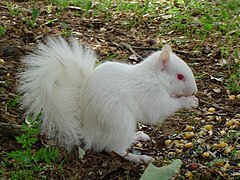Tree squirrel
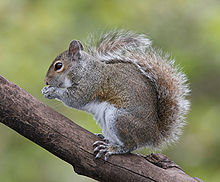
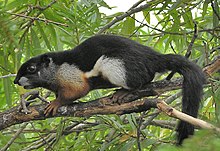
Tree squirrels are the members of the
They do not form a single natural, or
The best-known
Classification

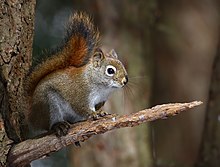
Current taxonomy, based on genetic data, splits the tree squirrels into several subfamilies. The following genera of the squirrel family are classified as tree squirrels.[3][5]
- Subfamily Ratufinae
- Genus Ratufa(Asian giant squirrels)
- Genus
- Subfamily Sciurillinae
- Genus Sciurillus(South American pygmy squirrel)
- Genus
- Subfamily Sciurinae
- Tribe Sciurini (mostly American tree squirrels)
- Genus Microsciurus (American dwarf squirrels)
- Genus Rheithrosciurus(Borneo tufted ground squirrel)
- Genus Sciurus (Eurasian and American tree squirrels)
- Genus Syntheosciurus(Central American mountain squirrel)
- Genus Tamiasciurus(American pine squirrels)
- Tribe Sciurini (mostly American tree squirrels)
- Subfamily Callosciurinae (Asian tree squirrels)
- Genus Callosciurus (Oriental tree squirrels, introduced into Europe and South America)
- Genus Exilisciurus (Asian pygmy squirrels)
- Genus Funambulus (Asian palm squirrels, introduced into Australia in the 1920s)[1][2]
- Genus Glyphotes(sculptor squirrel)
- Genus Nannosciurus(Asian dwarf squirrel)
- Genus Prosciurillus (Sulawesi dwarf squirrels)
- Genus Rubrisciurus(Sulawesi giant squirrel)
- Genus Sundasciurus (Sunda squirrels)
- Genus Tamiops(Asian striped squirrels)
- Subfamily Xerinae
- Tribe Protoxerini (African tree squirrels)
- Genus Epixerus(African palm squirrels)
- Genus Funisciurus(rope squirrels)
- Genus Heliosciurus(sun squirrels)
- Genus Myosciurus(African pygmy squirrel)
- Genus Paraxerus(bush squirrels)
- Genus Protoxerus(African giant squirrels)
- Genus
- Tribe Protoxerini (African tree squirrels)
Relationship with humans
Squirrels are generally inquisitive and persistent animals. In residential neighborhoods, they are notorious for tenaciously trying to circumvent obstacles in order to eat from
As pets

Squirrels have been kept as pets in Western society at least until the 19th century. Because of their small size and tame nature, they were especially popular with women and the clergy.[6]
As pests
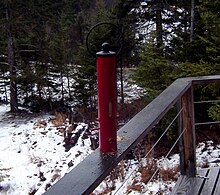
Squirrels are sometimes considered
Tree squirrels may bury food in the ground for later retrieval. Squirrels use their keen sense of smell to search for buried food, but can dig numerous holes in the process. This may become an annoyance to
Homeowners in areas with a heavy squirrel population must be vigilant in keeping
Squirrels are a serious
Some homeowners resort to more interesting ways of dealing with this problem, such as collecting and placing fur from pets such as domestic

Once established in a nest, squirrels ignore fake
To discourage chewing on an object, it can be coated or covered with something to make it distasteful: for instance a soft cloth doused with chili pepper paste or powder.[10] Capsaicin and Ro-pel are other forms of repellent.[9] To remain effective, the coating must be reapplied regularly, especially if it is exposed to the weather. Poisoning squirrels can be problematic because of the risks to other animals or children in the building, and because the odor of a dead squirrel in an attic or wall cavity is very unpleasant and persistent.[7]
An alternative method is to wait until squirrels have left in search of food, and then close up all their access openings, or to install one-way
Squirrels are often the cause of
Squirrels otherwise appear to be safe and pose almost zero risk of transmitting rabies.[17]
Squirrels cause economic losses to homeowners, nut growers, and forest managers in addition to damage to electric transmission lines. These losses include direct damage to property, repairs, lost revenue and public relations. While dollar costs of these losses are sometimes calculated for isolated incidents, there is no tracking system to determine the total extent of the losses.[18]
As roadkill and traffic hazards
In regions where squirrels are plentiful, tire-flattened
An effort to mitigate these hazards to both squirrels and humans is the Nutty Narrows Bridge in Longview, Washington, listed on the National Register of Historic Places. It provides a way for squirrels to cross a busy street safely.

As urban wildlife
Tree squirrels are a common type of urban wildlife.[23] They can be trained to be hand-fed, and will take as much food as is available because they cache the surplus. Squirrels living in parks and campuses in cities have learned that humans are typically a ready source of food, either deliberately or from careless disposal of surplus. Some people do "squirrel fishing" as a way of simultaneously playing with and feeding squirrels.
Humans commonly offer various nuts and seeds; however, wildlife rehabilitators in the field have noted that neither raw nor roasted peanuts nor sunflower seeds are healthy for squirrels, because they are deficient in several essential nutrients. This type of deficiency has been found to cause metabolic bone disease, a somewhat common ailment found in malnourished squirrels.[24][25][dubious ]
As game
Squirrels are sometimes hunted as
In the US
In many areas of the US, squirrels are still hunted for food, as they were historically.
Although squirrel meat is low in fat content, unlike most game meat it has been found by the American Heart Association to be high in cholesterol.[35]
Squirrels Unlimited[36] host a World Championship Squirrel cook-off each year in Bentonville, Arkansas.[37]
In the UK
For most of the history of the
Some Britons are eating gray squirrel as a direct attempt to help the native
Risks of eating
As with other wild game and
In 1997, doctors in
Relationship with trees
The biggest source of food for
In culture

In the Ramayana, an ancient Sanskrit epic poem, a squirrel assists in constructing a bridge from India to Sri Lanka to help Rama rescue his wife Sita.[50] Rama rewards the squirrel by stroking his back with his three middle fingers, thus giving the Indian palm squirrel the three white stripes that appear on its back.[50] In Norse mythology, the squirrel Ratatoskr is a messenger who scurries up and down the trunk of the world-tree Yggdrasil, carrying malicious gossip and insults back and forth between the dragon Níðhöggr, who sits at the bottom of the tree gnawing on its roots, and the hawk Veðrfölnir, who sits at the top of the tree keeping watch.[51][50][52] According to Richard W. Thorington, Jr. and Katie E. Ferrell, this legend may have originated from the red squirrel's habit of giving a "scolding alarm call in response to danger", which some Norsemen may have imagined as insults.[50]
In Irish mythology, the goddess Medb is said to always have a bird perched on one shoulder and a squirrel on the other, serving as her messengers to the sky and the earth respectively.[52] In Europe during the Middle Ages, squirrels were sometimes used in bestiaries as symbols of greed and avarice on account of their storing of nuts,[52] but, in the nineteenth century, British natural history books often praised them as thrifty for this same reason.[52] A myth told by the Ainu people of Japan holds that squirrels are the discarded sandals of the ancestral deity Aioina, possibly because squirrels move in spurts like footsteps.[52] The Kalevala, a Finnish epic poem collected in the nineteenth century but rooted in much older oral tradition, contains references to squirrels, including mention of a white squirrel being born of a virgin.[50]
Literary references to squirrels include the works of Beatrix Potter, Brian Jacques' Redwall series (including Jess Squirrel and numerous other squirrels), Pattertwig in C. S. Lewis' Prince Caspian, Michael Tod's Woodstock Saga of novels featuring squirrel communities in the style of Watership Down, and the Starwife and her subjects from Robin Jarvis's Deptford novels. The title character in Miriam Young's 1964 children's book Miss Suzy is a squirrel.
An episode of the radio program This American Life called "Squirrel Cop" describes the unintentionally humorous misadventure of a newly hired policeman in trying to remove a frantic squirrel from a homeowner's living room, which results in personal injury and a small fire.[54] First aired in 1998,[55] this episode turned out to be one of the most popular ones of the series,[56] prompting rebroadcasts and a lead position on the two-CD compilation Crimebusters + Crossed Wires: Stories from This American Life.
Albino and white squirrels
One of the ways that squirrels affect human society is inspired by the fascination that people seem to have over local populations of white squirrels (often misidentified as being albino).[57] This manifests itself by the creation of social group communities that form from a commonly shared interest in these rare animals. Other impacts on human society inspired by white squirrels include the creation of organizations that seek to protect them from human predation, and the use of the white squirrel image as a cultural icon.
Although these squirrels are commonly referred to as "albinos", most of them are likely non-albino squirrels that exhibit a rare white fur coloration known as leucism that is as a result of a recessive gene found within certain eastern gray squirrel (Sciurus carolinensis) populations, and so technically they ought to be referred to as white squirrels, instead of albino.[57][58]
A project run by Untamed Science is seeking to report and document the occurrence of both white squirrels, albinos, and other piebald morphs. Users are encouraged to submit their sightings.[59]
-
A true albino squirrel. Note the pink eyes.
-
Albino squirrel head on, showing blue irises
-
A leucistic squirrel. Note the non-pink eyes.
Local pride

Olney, Illinois, known as the "White Squirrel Capital of the World", is home of the world's largest known white squirrel colony. These squirrels have the right of way on all streets in the town, with a $500 fine for hitting one. The Olney Police Department features the image of a white squirrel on its officers' uniform patches.[60]
Along with Olney, there are four other towns in North America that avidly compete with each other to be the official "Home of the White Squirrel", namely: Marionville, Missouri; Brevard, North Carolina; Exeter, Ontario; and Kenton, Tennessee, each of which holds an annual white squirrel festival, among other things designed to promote their claim of "White Squirrel Capital".[61]
A list of white squirrel sightings around the world is maintained by the White Squirrel Research Institute, a group based in Brevard, North Carolina.[62]
Other towns that have reported white squirrel populations in North America (although not necessarily competing to be the "official" white squirrel capital) include
, Ontario is locally known for white squirrel sightings.Campus populations
In addition to the various towns that boast of their white squirrel populations, a number of university campuses in North America have white squirrels. The
In Kentucky, the University of Louisville has established its own chapter of the Albino Squirrel Preservation Society, which maintains contact with its members and interested parties through a Facebook group by that name. The university has an open policy to give away a free t-shirt to anyone who takes a photograph of a white squirrel on campus grounds and brings it to the administration offices.[72]
Other university campuses that have albino squirrel populations include Oberlin College in Ohio,[73] Ohio State University in Columbus, Ohio,[74] Western Kentucky University in Bowling Green, Kentucky (which has had a population of albino squirrels since the 1960s),[57] and Youngstown State University in Youngstown, Ohio.[citation needed]
Michael Stokes, a biology professor at Western Kentucky University, commented that the probable cause for the abundance of white squirrels on university campuses was because they were originally introduced by someone: "We're not sure how they got here, but I'll tell you how it usually happens...When you see them, especially around a college campus or parks, somebody brought them in because they thought it would be neat to have white squirrels around."[57]
Albert Meier, another biology professor at Western Kentucky University, added that: "... white squirrels rarely survive in the wild because they can't easily hide. But on a college campus, they are less likely to be consumed by other animals."[57]
In folklore
A story in which a
Red and grey squirrels in the UK

A decline of the
Currently,[
As of 2008, the eastern gray squirrel was regarded as vermin and it was illegal to release any into the wild; any caught could be released only if one applied for and was granted a licence to do so.[78] As of 2015, any caught in Scotland had to be humanely killed.[79]
See also
- American red squirrel
- Black squirrel
- Eastern gray squirrel
- Fox squirrel
- Red squirrel
- Squirrel
- Western gray squirrel
References
- Footnotes
- five-lined palm squirrels near Perth.
- Sources
- ^ ISBN 0-19-550870-X.
- ^ a b Seebeck, J. H. "Sciuridae" (PDF). Fauna of Australia. Archived from the original (PDF) on 2015-01-17. Retrieved 2013-11-24.
- ^ OCLC 263690320. Archived from the originalon 2013-01-02. Retrieved 2010-02-20.
- ^ "History of grey squirrels in UK". 18 March 2014. Retrieved May 30, 2020.
- OCLC 26158608.
- ^ Kathleen Walker-Meikle, Medieval Pets, Woodbridge: The Boydell Press, 2012, p. 14 et passim
- ^ a b c d e f g h "Guide to Safe Removal". Squirrels in the Attic. Retrieved 19 April 2012.
- ^ a b Byron, Ellen (February 27, 2013). "Critter Counteroffensive". Wall Street Journal.
- ^ a b c d e University of Illinois Extension. "Tree Squirrels > Damage Prevention and Control Measures". Living with Wildlife in Illinois. University of Illinois Board of Trustees. Retrieved 12 March 2013.
- ^ "Squirrel Control Techniques". Do It Yourself. DoItYourself.com. Retrieved 19 April 2012.
- ^ "How to Trap a Squirrel". Squirrel Place. The Squirrel Place. Archived from the original on 26 May 2012. Retrieved 6 May 2012.
- ^ "Controlling Tree Squirrels in Urban Areas" (PDF). Wildlife Damage Management. Texas Wildlife Damage Management Service. Retrieved 12 March 2013.
- ^ "Peaceful Coexistence". Compassionate Action Institute. Compassionate Action Institute, Inc. Archived from the original on 9 April 2012. Retrieved 19 April 2012.
- ^ K. Muston. "Getting Squirrely". Daily Kos. Retrieved 2008-02-07.
- ^ Gomez, Alan (11 Mar 2007). "Suicide squirrels driving utilities nuts". USA Today. Retrieved 19 April 2012.
- ^ "Guarding Your Home and Power". Critter Guard. Critter Guard, Inc. Retrieved 6 May 2012.
- ^ "Rabies and Squirrels". Rabies.emedtv.com. 2006-10-12. Retrieved 2012-05-06.
- ^ "Tree Squirrels – University of Georgia" (PDF). Hgic.clemson.edu. Archived from the original (PDF) on December 17, 2008. Retrieved 2012-05-06.
- ^ Marshall, Edward (March 31, 2008). "Squirrel blamed for accident: Couple struck head-on after woman swerves to avoid animal". The Journal (Martinsburg, WV). Archived from the original on 2 November 2013. Retrieved 6 May 2012.
- ^ "Driver says squirrels made him crash into garage". Chicago Sun-Times. October 3, 2011. Archived from the original on January 6, 2012. Retrieved 19 April 2012.
- ^ "Confused squirrel causes three-car accident". South Whidbey Record. Sound Publishing Inc. 25 Jun 2008. Archived from the original on 1 November 2013. Retrieved 19 April 2012.
- ^ "Swerving can be worse than hitting animal on road". USA Today. 11 Jan 2012. Archived from the original on May 4, 2012. Retrieved 6 May 2012.
- ^ "U.N.I.S. Urban Nature Information System: Squirrels". McGill University, Natural Resources Sciences. Retrieved 2013-01-10.
- ^ Saliga, Susan. "Backyard Squirrel Feeding Tips". Wisconsin Squirrel Connection. Retrieved 2014-10-23.
- ^ Rowe, Sara. "Squirrel Tales: Care Instructions For Infant Squirrels". Squirreltales. Retrieved 2007-02-07.
- OCLC 328071934.
- ^ Frauenfelder, Mark (2012-04-30). "How to make a squirrel sandwich". Boing Boing. Retrieved 2012-05-06.
- ISBN 978-0-486-15649-1.
- ISBN 978-0-316-06981-6.
- ^ It tasted like chicken. Retrieved December 19, 2008.
- ISBN 978-0-316-06981-6.
- ^ a b c Colquhoun, Kate (28 May 2008). "First, catch your squirrel...". The Telegraph. Archived from the original on 2022-01-12. Retrieved 6 May 2012.
- ^ a b Bilger, Burkhard (July 17, 2000). "Squirrel and man: is a local custom worth dying for?". The New Yorker. pp. 58–67. Retrieved 19 February 2013.
- ^ "Who invented Brunswick stew?". American Food Roots. 16 January 2013. Retrieved 3 October 2014.
- OCLC 55747419.
- ^ "World Championship Squirrel Cook Off Contact Page". World Championship Squirrel Cook Off. Retrieved 2 June 2018.
- ^ "Squirrels Unlimited-home". Squirrels Unlimited. Retrieved 2 June 2018.
- ^ a b c d e f Speiler, Marlena (January 6, 2009). "Saving a Squirrel by Eating One". The New York Times. Retrieved 2009-01-16.
- ^ a b c Burnham, Nigel (17 March 2009). "Eating the enemy: Alien species are being put on the menu in what campaigners say is the perfect green solution to save the UK's native animals". The Guardian. Retrieved 6 May 2012.
- ^ a b c "Grey squirrel hunter follows UK pie demand south: Founder of Red Squirrel Protection Partnership says trapping and shooting greys is the only way to save native reds". The Guardian. 29 May 2009. Retrieved 6 May 2012.
- ^ Wolf, Jeffrey (2007). "N.J. warns: Don't eat squirrel near dump". Denver, Colorado: KUSA/KTVD, Multimedia Holdings Corporation. The Associated Press. Retrieved 22 February 2010.
- ^ Sloan, Christine (Jan 25, 2007). "N.J. To Ringwood Residents: Don't eat the squirrel: Toxic dump may have led to lead contamination". New York: CBS Broadcasting Company. CBS. Archived from the original on October 1, 2009. Retrieved 22 February 2010.
- ^ Blakeslee, Sandra (August 29, 1997). "Kentucky Doctors Warn Against a Regional Dish: Squirrels' Brains". The New York Times. Retrieved 20 April 2012.
- ^ Jowers, Walter (September 22, 1997). "Bad Brains". Nashville Scene. DesertNet LLC. Retrieved 20 April 2012.
- ^ "A Man Contracted a Rare, Fatal Disease from Eating Squirrel Brains". 17 October 2018.
- ^ "The story behind the viral story about a man who ate squirrel brains".
- ^ "Promed Post".
- ^ Annaliese Griffin. "In the autumn, squirrels think about nuts so much that it may make their brains bigger". 2018.
- ^ Bob Hirshon, interviewing Rob Swihart. "Squirrel Hoarding". viewed 2021.
- ^ ISBN 0-8018-8403-9.)
{{cite book}}: CS1 maint: multiple names: authors list (link - ^ Völuspá 19, 27, 47; Grímnismál 29–35, 44; Gylfaginning 15
- ^ ISBN 1-57607-613-X.
- ^ Public Information Films | 1964 to 1979 | Film index | Tufty Under 5’s – Ice Cream Van
- ^ "Transcript | This American Life". www.thisamericanlife.org. 13 November 1998. Retrieved 2016-12-19.
- ^ "First Day". This American Life. 13 November 1998. Retrieved 2016-12-19.
- ^ "Fiasco!". This American Life. November 2013. Retrieved 2016-12-19.
- ^ OCLC 24620823. Retrieved 31 January 2018.
- ^ a b "Debunking the Albino Squirrel: Lack of white, pink-eyed critters on campus may disprove superstition" by Hudson Lockett, The Daily Texan, May 1, 2009.
- ^ a b The White and Albino Squirrel Phenomenon + New US Maps!
- ^ "Olney Illinois white squirrel history". Olney Illinois visitors information. City of Olney, Illinois. Archived from the original on January 25, 2010. Retrieved 11 February 2010.
- OCLC 40866142. Retrieved 11 February 2010.
- ^ White Squirrel Research Institute Homepage
- ^ Priest, Irvin. "Columbia". Missbab.com. Retrieved 2012-05-06.
- OCLC 45548250. Archived from the originalon November 3, 2012. Retrieved 11 February 2010.
The squirrel, which Lensing described as pure white with pink eyes, is a rare albino. About 1 in 100,000 squirrels in the state are thought to be albino, said Kristen Anchor, coordinator of Dane County Humane Society.
- ^ Burgeson, John, "White squirrels return to the area", p A9, August 13, 2010, The Advocate of Stamford, Connecticut
- ^ Gray, Jeff (22 August 2014). "The legend of the white squirrel". The Globe and Mail. theglobeandmail.com. Retrieved 2019-10-29.
- ^ (student), Paul. "The Lore of the Albino Squirrel". Archived from the original on 2013-10-24. Retrieved 2012-10-24.
- ^ Cahalan, Rose (25 June 2013). "Forty Acres Field Guide: Fox Squirrel". Alcade. Texas Exes. Retrieved 11 November 2019.
- ^ "The Albino Squirrel Preservation Society". albinosquirrel.com. Retrieved 17 May 2017.
- ^ "'Baby' is no more". North Texan. 56 (3). University of North Texas. Fall 2006. Retrieved 2008-02-07.
- OCLC 9940134. Retrieved 10 February 2010.
...albino squirrels also frequent the park.
- ^ "Visit campus" (Press release). University of Louisville. Retrieved 11 February 2010.
If you spot one of the unique albino squirrels on your campus visit and take a photo, you can receive a great prize!
- ^ Evtimova, Milena (November 12, 2004). "Explaining the discreet charm of Oberlin's albino squirrels". The Oberlin Review. Retrieved September 18, 2010.
- OCLC 25004888. Archived from the originalon December 4, 2009. Retrieved 11 February 2010.
Since the death of Whitey, a Facebook group titled, "In Memory of Whitey the Albino Squirrel," has been created to commemorate the life and death of the beloved south campus celebrity.
- ^ บาราย (2011-09-04). "กำเนิดหนองหาน". Thairath (in Thai). Retrieved 2017-10-25.
- ^ "The Grey/Red Debate". Save our Squirrels. Red Alert North England. Archived from the original on 2007-12-14. Retrieved 2008-02-07.
- ^ BBC (2003-03-07). "Virus threatens UK's red squirrels". BBC News. Retrieved 2008-05-30.
- ^ Malvern, Jack (2008). "Captured squirrels live to nibble again | The Times". The Times. Retrieved 2013-04-08.
- ^ "Control of invasive non-native species - Grey Squirrels". Retrieved 2013-04-08.
Further reading
- Duff, Andrew & Lawson, Ann (2004). Mammals of the World: A checklist. A & C Black. ISBN 0-7136-6021-X.
- Nowak, Ronald M. 1999. Walker's Mammals of the World, 6th edition. Johns Hopkins University Press, 1936 pp., ISBN 0-8018-5789-9
- Young, Miriam. 1964. Miss Suzy, Purple House Press, ISBN 1-930900-28-7
External links
- The Squirrel Lovers Club, an international club of squirrel enthusiasts.
- Squirrel-Rehab.org, includes advice and links for helping orphaned baby squirrels.

